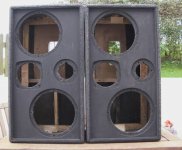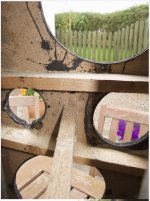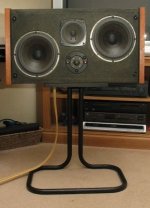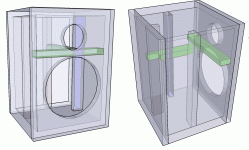we are going off-topic here, i was talking about cabinets, you ar enow bringing up the whole speaker
Crossovers are evil. The best XO is no XO, But if you want True 10 octave you have to compromise. One should at least keep it out of the critical band, and try to maintain 1/4 to 1/2 octave c-c driver separation
dave
Not going of topic...you asked for how I would brace cabinet. That's what I have submitted.
(crossovers are one of those necessary evils in the land of multi-way. Thankfully you can't hear the ones that I design)
Better than most and you gotta love the BB.
The baffle and drivers are missing their braces.
Would be better if the braces reached to the other side.
Drawing does not fully show brace placement.
Crossover <400 Hz?
dave
For this design, nothing is missing. No modification or additional bracing is necessary or recommended. The drawing shows the entire project. Sorry you can't see it. Crossover 2112Hz.
We indeed are off topic in posts 276 & 279.
Not likely i'll hear your XOs, i don't see myself in Jamacia NY anytime soon.
dave
Your loss, not mine. Have a great life!
didn't realize i forgot to paste the linkGuys, check out this video at 2.55. What is that thing they use to implement their tension system for the metal pole bracing?
Sonus faber - Aida product video - YouTube
Ah, sorue, yes, the link! Things getting heated here. Let's chill a bit, eh? Now you guys are NOT helping me with my problem of bracing my cheapie chipboard box!
I've found some inspiration in Mr Tibbs' lovely Gale GS401A restoration.
I need to brace across the weak point caused by the driver cutouts, hugely brace the back panel for mass and strength, and brace from front to back with a single hard strut to couple the mass of the bass to the back panel! OK, some issue with how it's gonna be mounted best, because the Gale's rested on their sides, but essentially sorted, eh! What do you think?
An externally hosted image should be here but it was not working when we last tested it.
I've found some inspiration in Mr Tibbs' lovely Gale GS401A restoration.
I need to brace across the weak point caused by the driver cutouts, hugely brace the back panel for mass and strength, and brace from front to back with a single hard strut to couple the mass of the bass to the back panel! OK, some issue with how it's gonna be mounted best, because the Gale's rested on their sides, but essentially sorted, eh! What do you think?
Attachments
Things getting heated here. Let's chill a bit, eh? Now you guys are NOT helping me with my problem of bracing my cheapie chipboard box!
It would take less work to build an entire new box than build my bracing system. I would suggest getting some 3/4"x1 1/2"(or so) hardwood strips. On back, and sides run them vertically just off centre. Not much place to get traction on the baffle, so run a horizonal strip across the space between the tweet & woof. Then turn that into a T such that you can secure it to the brace on the back. If you can the same from the back of the bass driver to the back of the box.
Much like tha Gales, but rectangular braces edge on make more sense than square ones.
Anymore and it is time to start from scratch.
dave
Based on the photo of your design, there is no need for additional bracing as there is no "weak point". Standard 19mm (or thereabouts) bracing along the length of all interior corners will be more than sufficient. You could include a brace horizontally across the interior face of your design between the two drivers, to intersect with the side braces, but it would absolutely not be necessary. I would say, be sure to compensate for the interior volume but as this appears to be a sealed enclosure, that would be less critical.
Based on the photo of your design, there is no need for additional bracing as there is no "weak point". Standard 19mm (or thereabouts) bracing along the length of all interior corners will be more than sufficient. You could include a brace horizontally across the interior face of your design between the two drivers, to intersect with the side braces, but it would absolutely not be necessary. I would say, be sure to compensate for the interior volume but as this appears to be a sealed enclosure, that would be less critical.
I thot you said bracing is key?
It is chipboard and i certainly looks like it has dimensions larger than 4-6". Braces in the corner have almost no effect.
dave
Bracing
No intentions on getting off on the wrong tangent.
Bracing "is" the key.
By "corner bracing" I mean interior bracing running the length of all interior dimensions, vertically and horizontally. Based on the estimated dimensions of the enclosure by viewing the photo, and even though this is chipboard, this type of bracing, while not only easy to implement, will also serve to render the enclosure dead. Just trying to help here.
No intentions on getting off on the wrong tangent.
Bracing "is" the key.
By "corner bracing" I mean interior bracing running the length of all interior dimensions, vertically and horizontally. Based on the estimated dimensions of the enclosure by viewing the photo, and even though this is chipboard, this type of bracing, while not only easy to implement, will also serve to render the enclosure dead. Just trying to help here.
The Cabinet is 18" H x 12" D x 10" W. Its gonna be impossible to get braces along the height into the cabinet, because I have not enough access. I'm wondering if I should just put two braces across the front either side of the woof, two similar across the back and two from the centre of those braces on the baffle to the back to link them. Like an H shape, if you follow...
Not interfere with the natural sound and damping of the cabinet if you see my thinking. Apropos that, would floating the speakers on foam be a good idea, or disastrous?
An externally hosted image should be here but it was not working when we last tested it.
Not interfere with the natural sound and damping of the cabinet if you see my thinking. Apropos that, would floating the speakers on foam be a good idea, or disastrous?
Ah ha! Now that changes things quite dramatically doesn't it! No access from the back? If that is the case, then your proposal is probably the best solution apart from planets10's suggestion to build a new box. You may however be able to fit the bracing in (2) pieces, from the front, through the woofer opening, for the back, vertically and horizontally. Then use your idea for the front bracing. Glued and screwed if you have access to the proper tools to get in there. It's not that large of a cabinet, so you should be fine.
edit: not sure about the foam idea.
edit: not sure about the foam idea.
Last edited:
If you brace the entire long dimension, then horizontal braces will not have much if any additional benefit.
One of the "rules" of bracing: a brace should create sub panels that have a higher aspect ratio than the panel being braced.
dave
I suppose that is true for a cabinet of this size especially. Makes it that much easier to implement also.
I would suggest getting some 3/4"x1 1/2"(or so) hardwood strips. On back, and sides run them vertically just off centre. Not much place to get traction on the baffle, so run a horizonal strip across the space between the tweet & woof. Then turn that into a T such that you can secure it to the brace on the back. If you can the same from the back of the bass driver to the back of the box.
(sketch not to scale)
With access only thru the the bass driver hole, you'll hav eto get creative. This is the scheme i described and could still be executed, but the long braces would need to be 2 pieces or shortened. I'd just overlap them and glue them togther. The braces are placed such that one edge is on the middle, so long braces would be height/2 + overlap (1 couple inches). 1/2 of the brace has one edge on the centre, the other hs the other edge on the centre. In the middle they overlap.
Some persuasion and rounding on ends, required to get the shorter braces in.
The closer you get the better.
dave
Attachments
Darn, can't get that image open, Dave.With access only thru the the bass driver hole, you'll hav eto get creative. This is the scheme i described and could still be executed, but the long braces would need to be 2 pieces or shortened. I'd just overlap them and glue them togther. The braces are placed such that one edge is on the middle, so long braces would be height/2 + overlap (1 couple inches). 1/2 of the brace has one edge on the centre, the other hs the other edge on the centre. In the middle they overlap.
Some persuasion and rounding on ends, required to get the shorter braces in.
The closer you get the better.
dave
Darn, can't get that image open, Dave.
Strange forum issue? I could see the pocture in my post, but it wasn't showing up as an attachment and if i tried to open the pic in a separate window it couldn't be found. I reattached it, you should be able to see it now.
dave
I'm having trouble with a small plethora of resonances in some woofer cabinets I've been building. I've used CLD panels with ply over MDF using soft polyurethane troweled thinly between them. I found that dropping a hammer on the panels sounded as though they would be effective.
These are just over 100l (4^3') and have cross bracing. I feel that the mechanical transferrence has been dealt with as they don't add that harshness, but they sound slightly 'hollow'. Using a stethoscope I heard emanations both above and below the panel resonance frequencies as per their dimensions (maybe spikes could help down low but that could be another issue).
The inner panels do not seem to couple well to the outer layers although maybe that isn't a bad thing, but to deal with the higher f (panel) resonances I intend to add a further outer layer of wood using something like PVA glue, and feel the panels could stand to be more stiff anyway. If the inner panel still resonates the f/g will take care of it.
Below the panel frequencies the fibreglass won't help as much and I might need more cross bracing but it gets tricky around the driver. I'm thinking the extra outer layer stiffness would help reduce what comes out of the box down low but I'm concerned that the inner panels would still resonate and couple to the cone. Would I be better to focus on bracing rather than the outer casing?
These are just over 100l (4^3') and have cross bracing. I feel that the mechanical transferrence has been dealt with as they don't add that harshness, but they sound slightly 'hollow'. Using a stethoscope I heard emanations both above and below the panel resonance frequencies as per their dimensions (maybe spikes could help down low but that could be another issue).
The inner panels do not seem to couple well to the outer layers although maybe that isn't a bad thing, but to deal with the higher f (panel) resonances I intend to add a further outer layer of wood using something like PVA glue, and feel the panels could stand to be more stiff anyway. If the inner panel still resonates the f/g will take care of it.
Below the panel frequencies the fibreglass won't help as much and I might need more cross bracing but it gets tricky around the driver. I'm thinking the extra outer layer stiffness would help reduce what comes out of the box down low but I'm concerned that the inner panels would still resonate and couple to the cone. Would I be better to focus on bracing rather than the outer casing?
I'm having trouble with a small plethora of resonances in some woofer cabinets I've been building. I've used CLD panels with ply over MDF using soft polyurethane troweled thinly between them. I found that dropping a hammer on the panels sounded as though they would be effective.
These are just over 100l (4^3') and have cross bracing. I feel that the mechanical transferrence has been dealt with as they don't add that harshness, but they sound slightly 'hollow'. Using a stethoscope I heard emanations both above and below the panel resonance frequencies as per their dimensions (maybe spikes could help down low but that could be another issue).
The inner panels do not seem to couple well to the outer layers although maybe that isn't a bad thing, but to deal with the higher f (panel) resonances I intend to add a further outer layer of wood using something like PVA glue, and feel the panels could stand to be more stiff anyway. If the inner panel still resonates the f/g will take care of it.
Below the panel frequencies the fibreglass won't help as much and I might need more cross bracing but it gets tricky around the driver. I'm thinking the extra outer layer stiffness would help reduce what comes out of the box down low but I'm concerned that the inner panels would still resonate and couple to the cone. Would I be better to focus on bracing rather than the outer casing?
This is one of the dangers of qualitative approach to managing problems rather than a quantitative approach.
Subjectivity will have you chasing your tail every time, trying ad-hoc solutions without understanding the nature of the problem.
If you feel you have a panel resonance problem, get one of those cheap piezo guitar pickups and glue that onto the cabinet wall in a grid fashion and take measurements with something like Holm just like you would a mic. Draw a grid on the panel and use hot melt glue to attach the sensor. Repeat until you have the surface mapped out. Then do the same thing for the next panel.
This way you can tell both the magnitude and the frequency of the resonances and when you try a solution, not only can you focus on the exact spot, you can tell exactly how much of an improvement you are making.
In the end you may discover that it isn't really a resonance problem after all, but you can't be sure until you perform measurements.
When you have completed your measurements, post your results so everyone can see them and help you decide your next step.
Otherwise, it is simply a game of try this, try that, until the cows come home.
I have one problem at around 150Hz that is greatest at the top corners of the baffle, also the lower corners but not so much the sides or open area of the front. It is also strong on the side panels starting at the side of the driver and reducing in level the further away from that point (ie: in an arc) over the side panels except near the two side braces I'm using.
- Status
- This old topic is closed. If you want to reopen this topic, contact a moderator using the "Report Post" button.
- Home
- Loudspeakers
- Multi-Way
- Bracing overkill yay or nay ?



